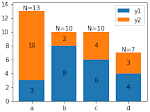Signature: plt.bar(*args, **kwargs)
Docstring:
Make a bar plot.
Call signatures::
bar(x, height, *, align='center', **kwargs)
bar(x, height, width, *, align='center', **kwargs)
bar(x, height, width, bottom, *, align='center', **kwargs)
The bars are positioned at *x* with the given *align* ment. Their
dimensions are given by *width* and *height*. The vertical baseline
is *bottom* (default 0).
Each of *x*, *height*, *width*, and *bottom* may either be a scalar
applying to all bars, or it may be a sequence of length N providing a
separate value for each bar.
Parameters
----------
x : sequence of scalars
The x coordinates of the bars. See also *align* for the
alignment of the bars to the coordinates.
height : scalar or sequence of scalars
The height(s) of the bars.
width : scalar or array-like, optional
The width(s) of the bars (default: 0.8).
bottom : scalar or array-like, optional
The y coordinate(s) of the bars bases (default: 0).
align : {'center', 'edge'}, optional, default: 'center'
Alignment of the bars to the *x* coordinates:
- 'center': Center the base on the *x* positions.
- 'edge': Align the left edges of the bars with the *x* positions.
To align the bars on the right edge pass a negative *width* and
``align='edge'``.
Returns
-------
container : `.BarContainer`
Container with all the bars and optionally errorbars.
Other Parameters
----------------
color : scalar or array-like, optional
The colors of the bar faces.
edgecolor : scalar or array-like, optional
The colors of the bar edges.
linewidth : scalar or array-like, optional
Width of the bar edge(s). If 0, don't draw edges.
tick_label : string or array-like, optional
The tick labels of the bars.
Default: None (Use default numeric labels.)
xerr, yerr : scalar or array-like of shape(N,) or shape(2,N), optional
If not *None*, add horizontal / vertical errorbars to the bar tips.
The values are +/- sizes relative to the data:
- scalar: symmetric +/- values for all bars
- shape(N,): symmetric +/- values for each bar
- shape(2,N): Separate - and + values for each bar. First row
contains the lower errors, the second row contains the
upper errors.
- *None*: No errorbar. (Default)
See :doc:`/gallery/statistics/errorbar_features`
for an example on the usage of ``xerr`` and ``yerr``.
ecolor : scalar or array-like, optional, default: 'black'
The line color of the errorbars.
capsize : scalar, optional
The length of the error bar caps in points.
Default: None, which will take the value from
:rc:`errorbar.capsize`.
error_kw : dict, optional
Dictionary of kwargs to be passed to the `~.Axes.errorbar`
method. Values of *ecolor* or *capsize* defined here take
precedence over the independent kwargs.
log : bool, optional, default: False
If *True*, set the y-axis to be log scale.
orientation : {'vertical', 'horizontal'}, optional
*This is for internal use only.* Please use `barh` for
horizontal bar plots. Default: 'vertical'.
See also
--------
barh: Plot a horizontal bar plot.
Notes
-----
The optional arguments *color*, *edgecolor*, *linewidth*,
*xerr*, and *yerr* can be either scalars or sequences of
length equal to the number of bars. This enables you to use
bar as the basis for stacked bar charts, or candlestick plots.
Detail: *xerr* and *yerr* are passed directly to
:meth:`errorbar`, so they can also have shape 2xN for
independent specification of lower and upper errors.
Other optional kwargs:
agg_filter: a filter function, which takes a (m, n, 3) float array and a dpi value, and returns a (m, n, 3) array
alpha: float or None
animated: bool
antialiased or aa: bool or None
capstyle: ['butt' | 'round' | 'projecting']
clip_box: a `.Bbox` instance
clip_on: bool
clip_path: [(`~matplotlib.path.Path`, `.Transform`) | `.Patch` | None]
color: matplotlib color spec
contains: a callable function
edgecolor or ec: mpl color spec, None, 'none', or 'auto'
facecolor or fc: mpl color spec, or None for default, or 'none' for no color
figure: a `.Figure` instance
fill: bool
gid: an id string
hatch: ['/' | '\\' | '|' | '-' | '+' | 'x' | 'o' | 'O' | '.' | '*']
joinstyle: ['miter' | 'round' | 'bevel']
label: object
linestyle or ls: ['solid' | 'dashed', 'dashdot', 'dotted' | (offset, on-off-dash-seq) | ``'-'`` | ``'--'`` | ``'-.'`` | ``':'`` | ``'None'`` | ``' '`` | ``''``]
linewidth or lw: float or None for default
path_effects: `.AbstractPathEffect`
picker: [None | bool | float | callable]
rasterized: bool or None
sketch_params: (scale: float, length: float, randomness: float)
snap: bool or None
transform: `.Transform`
url: a url string
visible: bool
zorder: float
.. note::
In addition to the above described arguments, this function can take a
**data** keyword argument. If such a **data** argument is given, the
following arguments are replaced by **data[<arg>]**:
* All arguments with the following names: 'bottom', 'color', 'ecolor', 'edgecolor', 'height', 'left', 'linewidth', 'tick_label', 'width', 'x', 'xerr', 'y', 'yerr'.
* All positional arguments.
File: ~/miniconda3/envs/py363/lib/python3.6/site-packages/matplotlib/pyplot.py
Type: function


